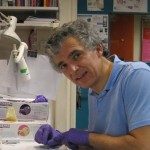Link to Pubmed [PMID] – 15477380
J. Gen. Physiol. 2004 Nov;124(5):541-54
Polyamines cause inward rectification of (Kir) K+ channels, but the mechanism is controversial. We employed scanning mutagenesis of Kir6.2, and a structural series of blocking diamines, to combinatorially examine the role of both channel and blocker charges. We find that introduced glutamates at any pore-facing residue in the inner cavity, up to and including the entrance to the selectivity filter, can confer strong rectification. As these negative charges are moved higher (toward the selectivity filter), or lower (toward the cytoplasm), they preferentially enhance the potency of block by shorter, or longer, diamines, respectively. MTSEA+ modification of engineered cysteines in the inner cavity reduces rectification, but modification below the inner cavity slows spermine entry and exit, without changing steady-state rectification. The data provide a coherent explanation of classical strong rectification as the result of polyamine block in the inner cavity and selectivity filter.
